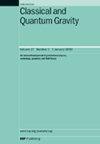ROXAS: a new pseudospectral non-linear code for general relativistic oscillations of fast rotating isolated neutron stars
IF 3.6
3区 物理与天体物理
Q2 ASTRONOMY & ASTROPHYSICS
引用次数: 0
Abstract
Next-generation gravitational wave detectors are expected to increase their sensitivity in the kHz band where binary neutron star (NS) remnants are expected to emit. In this context, robust predictions of oscillation modes of the post-merger object are desirable. To that end, we present here our codeROXAS:快速旋转孤立中子星广义相对论振荡的新伪谱非线性编码
下一代引力波探测器有望在双中子星(NS)残余物预计发射的千赫波段提高灵敏度。在这种情况下,对合并后天体振荡模式的可靠预测是可取的。为此,我们在这里提出了我们的代码相对论振荡的非轴对称中子星(ROXAS),旨在模拟孤立的旋转NSs。它是基于我们之前发表的依赖于原始变量的形式主义,以及爱因斯坦方程的扩展保形平坦性条件公式。这些方程式是用平衡良好的公式写成的。代码使用伪谱方法的度量和流体力学。由于在之前的文章中已经给出了标准的试验台,所以我们在这里主要介绍ROXAS的数值成分,以及轴对称和非轴对称模态的频率提取。我们将结果与半解析微扰方法进行了比较。球对称模式也恢复。该代码目前支持快速、刚性旋转的孤立nsss,用冷状态方程描述。我们通过赤道平面和π绕垂直z轴旋转施加对称。这些对称性包括占主导地位的四极性模式,即r =|m|=2模式。该代码的一个显著特征是它能够跟踪恒星表面的每一步。它非常轻巧,可以在办公电脑上运行。
本文章由计算机程序翻译,如有差异,请以英文原文为准。
求助全文
约1分钟内获得全文
求助全文
来源期刊

Classical and Quantum Gravity
物理-天文与天体物理
CiteScore
7.00
自引率
8.60%
发文量
301
审稿时长
2-4 weeks
期刊介绍:
Classical and Quantum Gravity is an established journal for physicists, mathematicians and cosmologists in the fields of gravitation and the theory of spacetime. The journal is now the acknowledged world leader in classical relativity and all areas of quantum gravity.
 求助内容:
求助内容: 应助结果提醒方式:
应助结果提醒方式:


